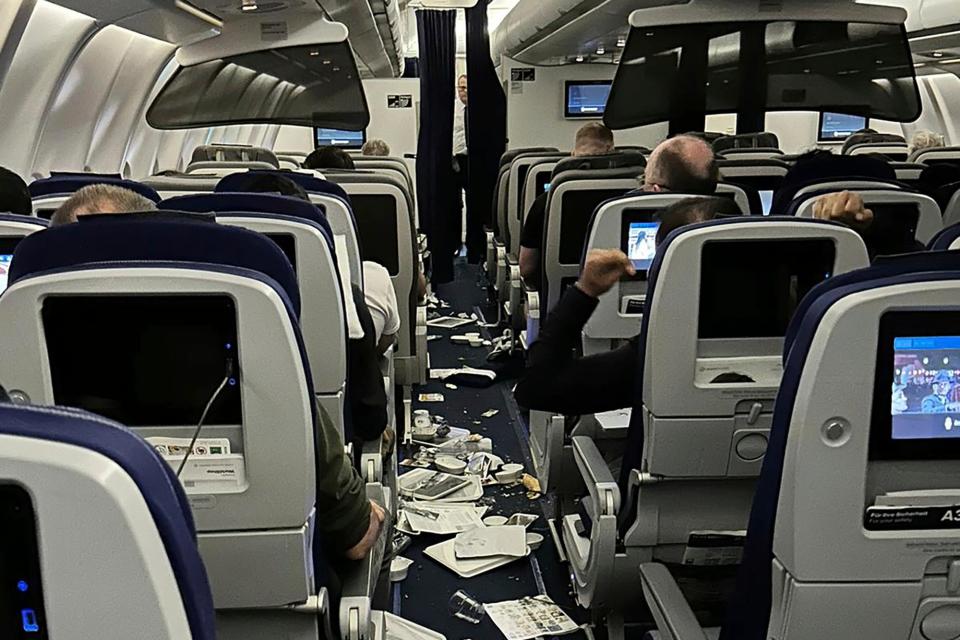Climate change is making turbulence worse, but here's why you shouldn't worry (too much)
"Green Travel” is a six-part series focusing on what it means to be sustainable travelers, how the industry is moving the needle on greener efforts, and how consumers can reduce their carbon footprint when exploring. If you'd like to contribute to our future reporting and share your experience as a source, you can click here to fill out this quick form.
Lufthansa flight 469 was en route from Austin, Texas, to Frankfurt, Germany, on March 1 when it hit a severe patch of turbulence and had to divert to Washington. Seven people onboard went to the hospital with injuries after the plane landed, and photos taken aboard showed debris covering one of the aircraft's aisles.
Events like that could become more common as global temperatures rise.
Turbulence is getting worse, and that trend is likely to continue because of climate change. Here's what climate and aviation experts said about the worsening turbulence trends.
Tell us your story: Mobility device lost or damaged by an airline? USA TODAY wants to hear about it.
What causes turbulence?
There are different kinds of turbulence, and they're caused by different things:
Mountain wave turbulence, as the name suggests, happens when the wind hits a mountain and is forced upward off its blustery path. That's why it's common to hit some bumps when you're flying over the Rockies on a transcontinental flight.
Convective turbulence is generally associated with storms and is caused by warm air rising.
Clear air turbulence can be caused by a number of factors and is generally harder to predict than the other two types, but it is also the most likely kind to affect aircraft. And because it's harder to predict, it can also be harder to avoid.

Is climate change making turbulence worse?
Yes, at least with clear air turbulence.
According to Paul Williams, a professor of atmospheric science at the University of Reading, there's no clear data on how climate change is affecting mountain waves or convective turbulence, but clear air turbulence is definitely becoming more frequent and intense.
"It's going up because of climate change," Williams said. "The atmosphere is getting more turbulent; there will be more severe turbulence in the atmosphere."
Thomas Guinn, chair of applied aviation sciences at Embry-Riddle Aeronautical University, agreed.
Cruising Altitude: Why air rage on airplanes is every traveler's problem
"Turbulence is going to tend to become more frequent and more intense with climate change," he said.
Both Williams and Guinn pointed out that severe turbulence is actually increasing more acutely than lighter chop.
Recent studies Williams has worked on show severe turbulence is increasing by 149% increase versus 59% for light turbulence. However, severe turbulence will likely remain very rare.
"The absolute amount of turbulence is small," Williams said. "Naught 0.1% of the atmosphere has severe turbulence in it currently; that’s tiny."
Even as severe turbulence increases, Williams said it won't be commonly experienced by the average flyer.
Behind the scenes: This company makes jet fuel out of just air and water
"A 149% increase, that’s somewhere between a doubling and a tripling," he said. "You can take 0.1% and double it or triple it. It’s still going to be only 0.2 or 0.3%."
The seasonality of turbulence is also shifting as the climate changes.
Currently, clear air turbulence is more common in the winter, but it's starting to happen more frequently in the warmer months, too.
"In summer in the future, the amount of clear air turbulence will be as common as it is in winter currently," Williams said, pointing to the example of a Hawaiian Airlines flight that encountered severe turbulence in December.
Is turbulence dangerous?
It doesn't have to be.
Even as severe turbulence increases, "it's going from being really, really rare to still rare," Williams said. And even when a plane does encounter severe turbulence, passengers can generally stay safe so long as they're wearing their seat belts.
"Anytime somebody asks me about turbulence, I say the same thing," Guinn said. "If you're fastened in your seat belt, the odds of getting injured in a turbulence event are low."
Williams agreed that passengers could typically stay safe in turbulence so long as they're buckled up but added that worsening turbulence poses a much greater danger to flight attendants.
'A most challenging summer': JetBlue worries over FAA staffing as Amsterdam tickets go on sale
"I think something like 80% of the injuries is to flight attendants," he said, adding that as turbulence forecasting becomes more reliable and aircraft become more advanced, turbulence may have less of an effect on flights.
Can planes withstand severe turbulence?
Yes, planes are designed to withstand even extreme turbulence, so it may be uncomfortable for passengers, but it almost never puts the plane itself in physical danger, according to Guinn. The bigger problems, he said, are the other complications turbulence can cause.
"If you can climb above it or go below it, that fixes things, but that costs a lot of fuel," Guinn said. "Prolonged exposure to turbulence for a pilot is fatiguing. Pilots are going to have to deal with that as well."
It's tough on other parts of the aviation sector as well.
"If there’s three times as much turbulence in the atmosphere, that’s three times the obstacles you have to avoid as a pilot," Williams said. "Every time a pilot tries to go around turbulence, it adds to the workload of air traffic controllers and pilots.
Have you experienced severe turbulence lately? How was that experience?
Zach Wichter is a travel reporter and columnist for USA TODAY based in New York. You can reach him at zwichter@usatoday.com
This article originally appeared on USA TODAY: What causes turbulence? Here's what's making it worse

 Yahoo Sports
Yahoo Sports 